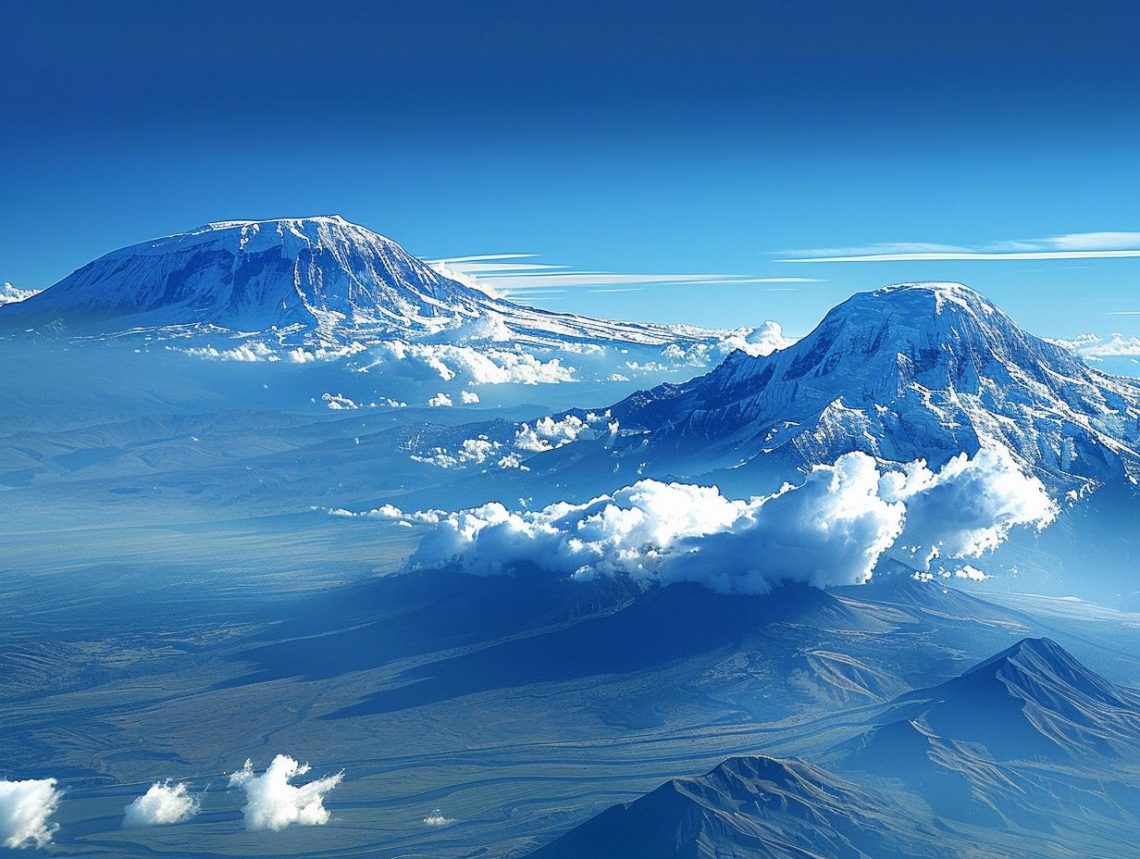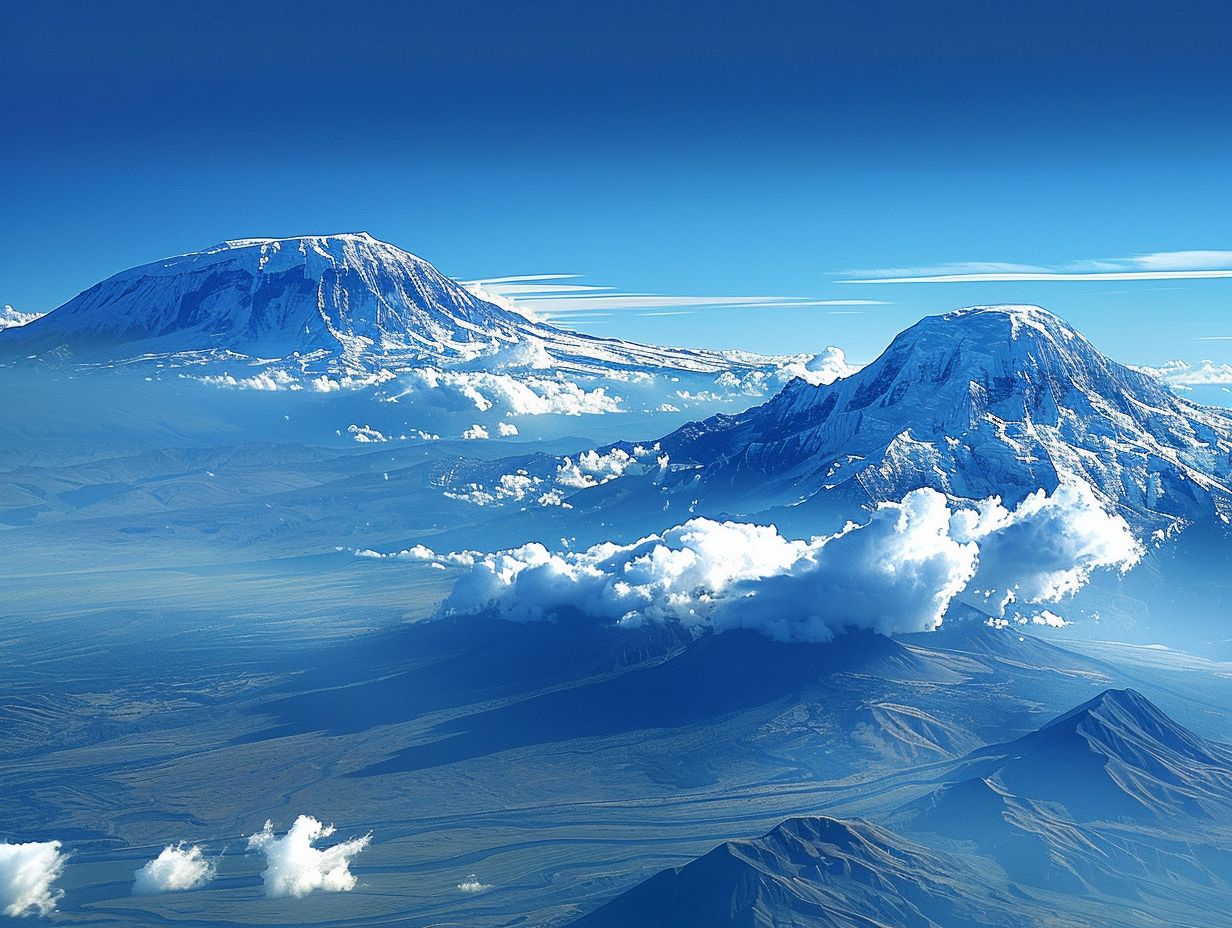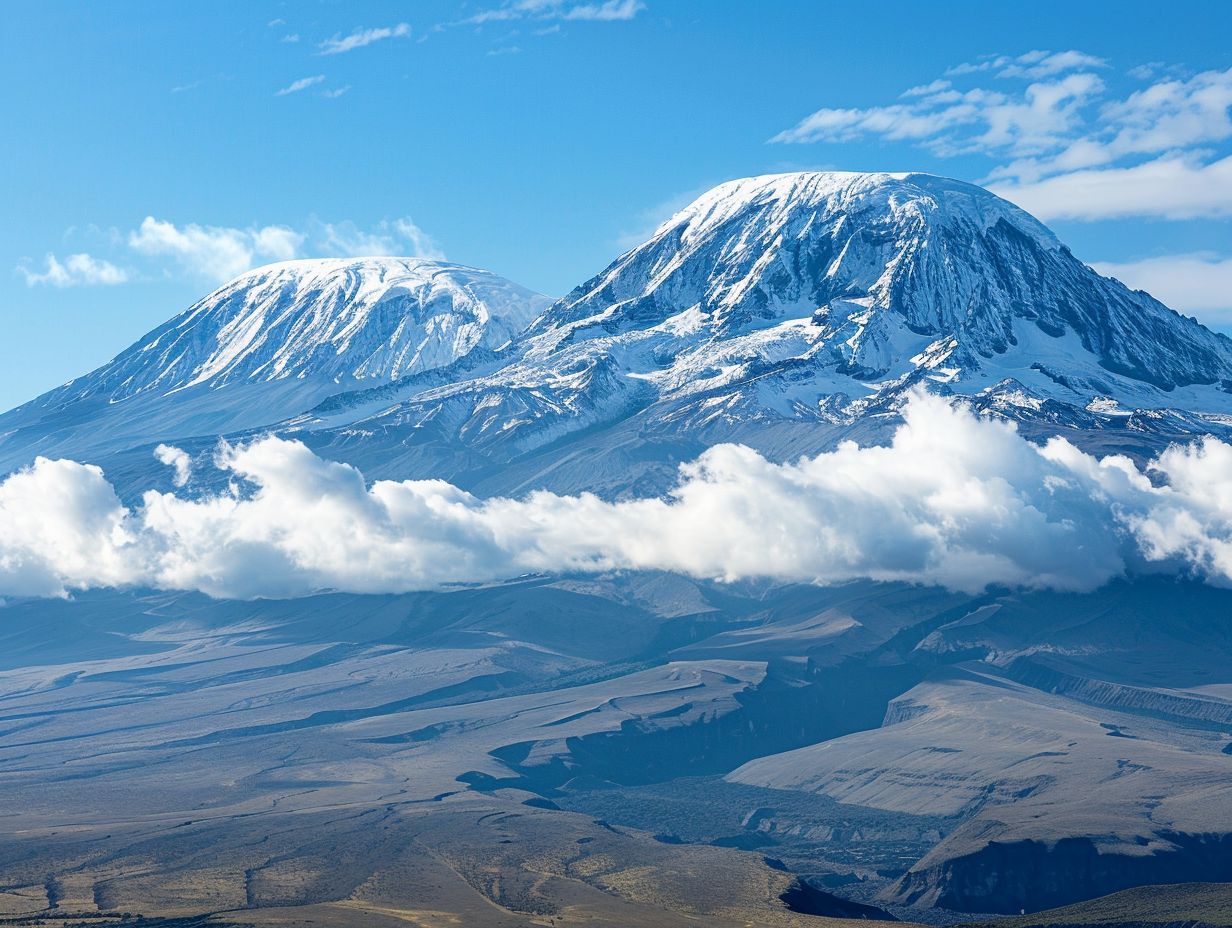
Kilimanjaro Vs Elbrus
Have you ever dreamed of conquering towering peaks and experiencing the thrill of high-altitude climbing?
Kilimanjaro and Elbrus are two of the most iconic mountains in the world, each offering a unique challenge and adventure for climbers.
In this article, we will explore the differences between Kilimanjaro and Elbrus in terms of location, elevation, difficulty level, climbing routes, weather, and cost.
We will also discuss the popularity of each mountain, their similarities, and provide essential gear and preparation tips for those brave enough to take on these incredible summits.
Join us as we compare these majestic mountains and help you decide which one is right for your next mountaineering adventure.
Key Takeaways:

- Kilimanjaro and Elbrus are two popular mountains for climbers, but they have distinct differences in location, elevation, difficulty level, routes, weather, and cost.
- Both Kilimanjaro and Elbrus share similarities such as being part of the Seven Summits, having volcanic origins, cultural significance, and offering stunning views.
- When deciding on which mountain to climb, consider your fitness level, budget, and preference for African or European culture and landscape.
What Are Kilimanjaro and Elbrus?
Kilimanjaro and Elbrus are two iconic mountains known for their majestic summits and challenging climbs, attracting climbers from around the world.
One of the distinguishing features of Kilimanjaro is its status as the highest freestanding mountain in the world, towering at approximately 19,341 feet in Tanzania.
Its various ecological zones, from lush rainforests to alpine deserts, provide climbers with a unique experience of diverse landscapes during their ascent.
Conversely, Elbrus, located in the Caucasus Mountains of Russia, stands as Europe’s highest peak, reaching about 18,510 feet.
Its twin summits, covered in glaciers, offer a stark contrast to Kilimanjaro’s volcanic terrain, presenting a different kind of challenge for mountaineers.
Both mountains hold significant geographical importance, with Kilimanjaro being a dormant volcano and Elbrus considered an extinct volcano.
What Are the Differences Between Kilimanjaro and Elbrus?
Kilimanjaro and Elbrus differ in several aspects such as altitude, technical difficulty, terrain features, and climbing conditions, making each mountain a unique challenge.
In terms of altitude, Kilimanjaro stands out as the highest peak in Africa, towering at approximately 5,895 meters above sea level, whereas Elbrus ranks as Europe’s highest mountain peak, reaching heights of 5,642 meters.
The altitude variations between the two mountains significantly impact the level of acclimatization needed for climbers.
1. Location and Elevation
Kilimanjaro’s location in Africa and Elbrus’s position in Europe/Asia demonstrate the diverse geographical settings of these mountains.
Kilimanjaro, the highest peak in Africa, stands at approximately 5,895 meters above sea level, making it one of the most accessible high summits for climbers.
On the other hand, Mount Elbrus, the highest peak in Europe, is located in the Caucasus Mountains of Russia, with its western side in Europe and the eastern side in Asia.
Elbrus reaches an impressive elevation of around 5,642 meters (18,510 feet), providing a challenging yet rewarding climb for adventurers.
2. Difficulty Level
The difficulty levels of Kilimanjaro and Elbrus vary significantly, with Kilimanjaro known for its trekking challenges and Elbrus for it’s technical climbing requirements.
Regarding Kilimanjaro, climbers face a strenuous trek through various climates and terrains testing their endurance and determination.
On the other hand, conquering Elbrus demands a higher level of technical skill, including the use of ice axes, crampons, and roped glacier travel.
Climbers must possess not only physical stamina but also knowledge of crevasse rescue and self-arrest techniques to tackle the challenges that Elbrus poses.
3. Climbing Routes

Kilimanjaro and Elbrus offer diverse climbing routes that cater to varying levels of experience, with guide companies and porters available to assist climbers.
On Kilimanjaro, routes like the Machame and Marangu provide options for trekkers seeking different challenges, from more gradual ascents to shorter, steeper paths.
Guide companies play a crucial role in educating climbers about the changing terrain and altitude risks. Engaging experienced guides helps in acclimatizing effectively.
Similarly, Elbrus boasts routes such as the North and South approaches, each with its unique set of challenges and scenic views.
Porter services on both mountains are critical for carrying gear and supplies, lightening the load for climbers and aiding in a successful ascent.
4. Weather and Climate
The weather and climate on Kilimanjaro and Elbrus present unique challenges to climbers, with altitude variations, terrain conditions, and snow/ice factors.
These mountains boast distinct microclimates due to their geographical locations and elevation gradients.
Kilimanjaro, located near the equator, experiences fluctuating temperatures from the tropical base to the arctic summit.
Conversely, Elbrus, situated in the Caucasus range, encounters colder temperatures and volatile weather patterns influenced by it’s position.
5. Cost and Logistics
The cost and logistics of climbing Kilimanjaro and Elbrus vary based on factors such as guide company services, route selections, and expedition requirements.
When planning your climb, it’s essential to consider the expenses associated with permits, gear rental, accommodation, and travel arrangements.
Porters play a crucial role in assisting climbers, carrying equipment, and setting up camp, alleviating some of the physical burdens.
Some companies provide all-inclusive packages that cover most expenses, while others offer more basic services with additional costs for equipment and permits.
The choice of route can impact the overall cost, with some routes requiring more logistical support and resources.
Which Mountain is More Popular for Climbing?
Kilimanjaro and Elbrus both attract a significant number of climbers, but Kilimanjaro has gained more popularity due to it’s iconic status and accessibility.
While Kilimanjaro boasts the distinction of being the highest peak in Africa, Elbrus stands as the highest point in Europe.
The pristine snow-capped summit of Kilimanjaro juxtaposed with the rugged terrain of Elbrus offers contrasting challenges for mountaineers.
The accessibility of Kilimanjaro with well-established routes and proximity to tourist-friendly destinations like Tanzania’s Serengeti National Park adds to it’s allure.
On the other hand, Elbrus, situated in the Caucasus range, offers a rich historical background, having been a significant part of Russian folklore and history.
This historical significance lends a mystical aura to the mountain, attracting climbers intrigued by tales of past conquests and legends associated with the region.
What Are the Similarities Between Kilimanjaro and Elbrus?
Despite their differences, Kilimanjaro and Elbrus share commonalities such as being part of the Seven Summits challenge.
1. Seven Summits
Kilimanjaro and Elbrus are both part of the renowned Seven Summits challenge, attracting climbers seeking to conquer the highest peaks.
Standing at 19,341 feet, Kilimanjaro offers climbers a unique experience with its diverse ecosystems, ranging from lush rainforests to snow-covered peaks.
Climbing this volcanic massif in Tanzania requires endurance and determination as hikers navigate through various climate zones.
On the other hand, Mount Elbrus in Russia, presents a different set of challenges with freezing temperatures and unpredictable weather conditions.
Completing expeditions not only demands physical strength but also mental resilience, as climbers often encounter altitude sickness and extreme weather.
The allure of standing on the summit of Kilimanjaro or Elbrus is a dream for many adventurers, symbolizing achievement and pushing the limits of human potential.
2. Volcanic Origin

Both Kilimanjaro and Elbrus have volcanic origins, contributing to their unique geological formations that intrigue climbers and geologists.
Volcanic activity played a pivotal role in shaping these majestic peaks, with remnants of ancient eruptions visible across their landscapes.
Volcanic rock formations, such as lava flows and volcanic ash deposits, add layers of intrigue to the geological tapestry of these mountains.
Over millions of years, volcanic processes sculpted the distinctive shapes and contours that define the allure of Kilimanjaro and Elbrus.
3. Cultural Significance
Kilimanjaro and Elbrus hold cultural importance for the local communities surrounding them, with traditions, stories, and rituals tied to these majestic mountains.
Through age-old narratives and indigenous customs, these mountains have become embodiments of ancestral wisdom and spiritual connection.
Legend has it that spirits reside in the rocky crags and snow-capped peaks, guiding climbers on their journey and instilling a sense of reverence.
Local communities celebrate festivals and events that honor the mountains, fostering a sense of unity and pride among those living in their shadow.
4. Stunning Views
Climbers on Kilimanjaro and Elbrus are treated to breathtaking views of the surrounding landscapes, with stunning panoramas.
As climbers ascend these majestic peaks, they are greeted by spectacular vistas that stretch as far as the eye can see, offering a visual feast of rugged wilderness.
The captivating panoramas of dense forests, glacier-capped peaks, and expansive valleys create an awe-inspiring backdrop for their journey.
The scenic beauty that unfolds before them is a symphony of colors and textures, with each twist and turn revealing a new tableau of nature’s artistry.
From the dramatic sunrises painting the sky in hues of orange and pink to the distant horizons dotted with other towering peaks.
Which Mountain is Right for You?
Choosing between Kilimanjaro and Elbrus depends on your climbing preferences, skill level, and desired challenge, with Kilimanjaro offering trekking experiences and Elbrus presenting technical climbing opportunities for adventurers.
When considering Kilimanjaro, the highest peak in Africa, hikers are drawn to its scenic beauty, diverse ecosystems, and the challenge of reaching Uhuru Peak.
On the other hand, Elbrus, the highest summit in Europe, lures climbers seeking a more technical ascent, with glaciers, steep slopes, and unpredictable weather.
Altitude variation also sets these peaks apart, with Kilimanjaro’s gradual ascent providing better acclimatization compared to Elbrus’s rapid gain in altitude.
Route options differ as well, with Kilimanjaro boasting multiple trails like the popular Marangu and Machame, while Elbrus offers routes such as the North Side and the more straightforward South Route.
What Are the Essential Gear and Preparation for Climbing Kilimanjaro and Elbrus?

Preparing for climbing Kilimanjaro and Elbrus involves essential gear like proper footwear, clothing, and equipment tailored to the trekking or technical climbing requirements.
Climbers need to choose suitable hiking boots that provide support and comfort, along with clothing that offers protection from the changing weather conditions.
Packing a sturdy backpack with essentials like water bottles, nutrition-rich snacks, navigation tools, and first aid kits is crucial for any successful ascent.
Acclimatization strategies such as gradual altitude gain and staying hydrated play a vital role in preventing altitude sickness.
Frequently Asked Questions
1. What is the difference in height between Kilimanjaro and Elbrus?
A: Kilimanjaro, located in Tanzania, stands at 19,341 feet (5,895 meters) while Elbrus, located in Russia, stands at 18,510 feet (5,642 meters).
2. Which mountain is considered the highest in Africa?
A: Kilimanjaro is the highest mountain in Africa, making it a popular destination for hikers and climbers.
3. Are both Kilimanjaro and Elbrus considered part of the Seven Summits?
A: Yes, both Kilimanjaro and Elbrus are part of the Seven Summits, which is a list of the highest mountains on each continent.
4. What type of terrain can be expected on Kilimanjaro and Elbrus?
A: Kilimanjaro is a volcanic mountain, while Elbrus is a dormant volcano. Both mountains have a mix of rocky and snowy terrain, with Kilimanjaro also featuring lush vegetation.
5. Which mountain is more challenging to climb, Kilimanjaro or Elbrus?
A: While both mountains require a certain level of physical fitness and preparation, Elbrus is generally considered more technically challenging due to steeper and more technical sections.
6. What is the best time of year to climb Kilimanjaro and Elbrus?
A: The best time to climb Kilimanjaro is from June to October, while the best time for Elbrus is from July to September. These months offer more stable weather and better climbing conditions.